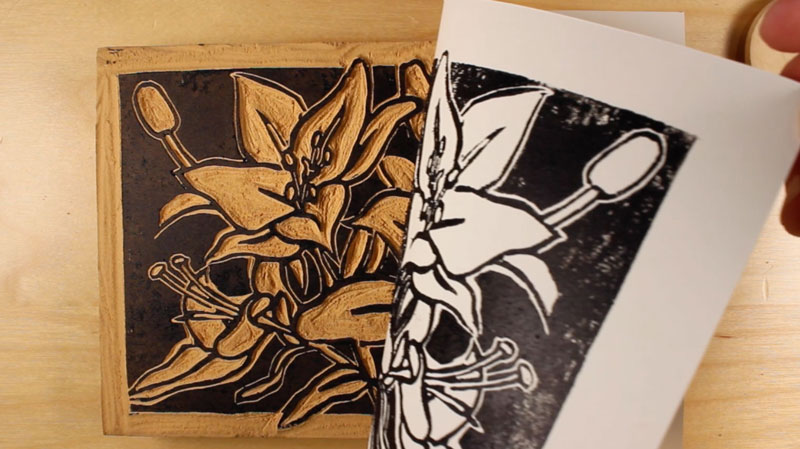Relief Process
In the Relief process, paper is pressed against ink on top of carved wood to create a 2d image with a 3d look to it.To begin this process, start by toning the block with an Indian ink wash or a wash of a jet black film ink. Once you're done, the drawing can be transferred onto the wood with the aid of an iron oxide or carbon paper transfer. After that, you can either use a white line or black line composition. White/black line composition gives the art a 3 dimensional look. After an image is carved onto the block of wood, ink is rolled onto the wood and a thin piece of paper is laid on top. Lastly, the image is transferred to the paper by pressing down on the paper with a baren.
 |
| Example of Relief Process |
Intaglio Processes
An Intaglio process is any print making process where the image area is below the flat surface of your printing matrix or plate. There are many different versions of the Intaglio process. Some of these Intaglio processes are dry point and etching.In the dry point process, you directly move or scratch the material on the plate. When scratching the surface, use etching tools. An example of an etching tool is a steel scribe. What you're doing is moving the metal to raise a burr. The ink will later be held on these burrs, creating a fuzzy line. You then use different tools to add texture to the image. An example of a tool that would create texture is the roulette.
In the etching process, you'll use similar tools to the dry point process. First, polish and clean the plate. Next, you'll apply a ground to the plate to act as an acid resist. Once the ground is applied to the plate, the color of the surface should be jet black. Then, you can draw on the plate by scratching the plate. Instead of raising burrs, it'll be scratching away the ground to reveal copper. The copper lines are what will be printed onto the paper. Next, the plate is etched for 15 minutes, rinsed, then etched again for another 15 minutes. All you have to do now is wipe the plate with ink and press paper onto it at high pressure.
 |
| Example of Intaglio Process |
_____________________________________________________________________________
Lithography Process
In Lithography, an artist will draw using a greasy material on a lithographic stone. Lithography revolves around how grease and water resist each other.
Firstly, create a drawing using a greasy material on the stone. Then, you'll apply chemicals onto the stone such as gum arabic to establish the areas where water will go. Rosin and talc will help when you etch the stone. After that, you can draw over the original drawing with things like lithopencils and lithographic crayons. Then, you'll be ready to etch. Apply gum arabic to the non-image areas, then apply acidified gum arabic, then apply more gum arabic. Use a cheesecloth to buff the gum arabic in nice and evenly. Then, wash the stone with lithotine. It will look like your drawing disappeared but it's still there. Next, buff the asphaltum onto the stone. Now, you're done etching the stone. Wetten, dry, sponge, then ink the stone. Then, you force ink into the stone. After 4 to 6 news prints, you'll finally get the full image onto a piece of paper.
 |
| Example of Lithography Process |